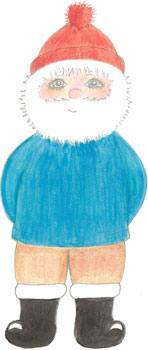
Salty Sam’s Fun Blog for Children
Number 352
Pears
Hello Everyone

A very interesting thing happened last week.
Actually, it happened to Miss Pringle and she told her class all about it.
The children in her class went home and told everyone they saw – and from there the news spread about the town.
This is what happened…
Miss Pringle was out for a walk with her boyfriend, Steve, at the weekend.
He had promised to take his neighbour’s dog for a walk because she was in bed with flu.
The couple went for a long walk and it turned into a bit of an epic ramble.
Then at one point, the naughty, little dog managed to slip away from them and run away.
This is not a good thing to happen in the countryside. Dogs must always be kept on a lead so that they don’t chase after livestock.
The dog had suddenly seen a rabbit and bolted after it.
Well, Miss Pringle and her boyfriend ran after the dog and it disappeared over a stone wall and into the undergrowth.
The rabbit managed to get away and the dog stopped just before it got tangled up in some brambles.
Miss Pringle had never seen this place before.
lt was an area of land surrounded by a very high stone wall. Some of the wall had tumbled down and left a bit of a gap at the top of the wall and a pile of stones at the bottom.
This is how the dog had got through to the other side of the wall.
Miss Pringle clambered through the gap in the wall and grabbed onto the dog’s lead.
Then she looked around her. She could see what seemed to be a very, very overgrown orchard.
There were apple trees and lots of pear trees that were in the process of losing their autumn leaves.
The whole place was really overgrowth with bushes and tall grass and blackberry brambles.
She wondered who the land belonged to. lt obviously had not been cared for for years.
Anyway, it was time to take the dog back home and return it to its owner.
They bought Steve’s neighbour some fruit as a present to help her get better on the way home.
After Miss Pringle had gone to bed that night, thoughts started running through her head. lt seemed such a waste that a beautiful orchard like that had gone to rack and ruin and she wondered if it could be restored.
lt would take a lot of work to do it – and a lot of people to do the work.
The orchard was at the back of the church yard and so Miss Pringle went to see the vicar the very next day to see if he knew who the land belonged to.
She knew where she would find him on a Sunday morning!
The vicar said that the land actually belonged to the church and the two of them discussed the idea of starting a community orchard.
The vicar said that he would take the matter up with the bishop and see what could be done.
Miss Pringle went home to do some research.
She knew that if you want to make a success of any project, the first thing you must do is some research. That means learn about how to do things before you do them.
The first thing she did was look at how to set up a community orchard, and then she started researching how to look after fruit trees.
There was a lot to learn and it took her all day.
The first fruit she learned about were pears. There seemed to be a lot of pear trees in the corner of the orchard that she was standing in.
Pears taste delicious straight from the tree. You might have one or two pear trees in your back garden.
lt is thought that pears first came from the Caucasus – that is a mountain range that runs across Turkey, Georgia and lran.
lt is likely that it was the Romans that took them across Europe and then into Britain like they did apples. ln those days, they might have been used in cooked dishes with honey and spices as well as eaten raw.
After the collapse of the Roman Empire, the cultivation of pears would have been continued by monks living in monasteries.
Henry Vlll’s fruiterer, Richard Harris, introduced continental varieties to the royal orchards of Kent. They mainly came from Belgium and France.
Over the next two centuries, many pear varieties were improved upon through careful cultivation. Their flesh became less gritty and much softer.
There are varieties of Asian pears that can be grown in Britain too. They are more of a round shape than European pears and need more heat to thrive.
Pears do well on a warm, sheltered site. They grow well in most soils.
They like it to be free-draining but not too thin and dry. They like feeding and mulching at the right time of year so that they can grow fit and strong and be able to ward off pests and diseases.
When you plant a number of pear trees together, the varieties have to be chosen carefully so that they will cross-pollinate well and produce pears every year. Pear trees have beautiful white blossom in early spring.
There are dessert varieties – that means you eat them raw and they taste nice and sweet, and cooking varieties as well. Actually, all pears can be cooked, although some give better results than others.
They can also be used to make drinks. When pears are juiced they make a thicker juice than apples. The alcoholic drink made from apples is called cider and the one made from pears is called perry. There are special, less-sweet pears that are grown especially for perry production. These trees quite like heavier, clay soils.
Pears can also be stored as dried fruit if prepared properly. Pears do not freeze well, but can be bottled in sugar-solutions or pickling-solutions. They can also be put in preserves like chutneys or jam.
Pears can be picked when they lift easily off the tree. They can be left to ripen on a sunny window sill. Pears that are soft right at the top by the stalk are ready to eat. They don’t store as well as apples.
The trees need looking after properly. Dead wood needs to be clipped out and fruit might need to be thinned too. Harvesting of pears needs to be done at the right time.
But pears are a very good fruit to eat for your health and so are well-worth growing.
Miss Pringle went on to read about apples and continued to read into the evening.
She realised there was so much to do if the orchard was to be restored properly.
But she also knew that a lot of people working together can achieve a lot if they put their minds to it.
More news about the Rocky Bay Community Orchard next week…
Bye bye everyone – don’t forget to subscribe to my blog!
lf you like my blog, please support it by telling all your friends and followers about it.
Thank you!
And see you again next Fun Friday!
Love and kisses
Salty Sam

www.christina-sinclair.com


Bill and Bob’s Joke of the Week![]()
![]()
Bob: Did you hear about the farmer who had ten achers?
Bill: Ten acres? Really? That isn’t much land.
Bob: No! He had tight shoes – his toes were hurting!

Salty Sam © Christina Sinclair 2015
Unauthorized use and/or duplication of material from this blog without express and written permission from this blog’s author and owner is strictly prohibited.
Links may be used to www.christina-sinclair.com

Picture Gallery



 THE SALTY SAM NEWS DESK
THE SALTY SAM NEWS DESK

In her never-ending pursuit to improve her class’s English, Miss Pringle explained to them this week the meaning and use of euphemisms.
A euphemism is a soft and gentle way of giving information that could be harsh or upsetting to hear.
For example, you could say that someone has ‘passed away’ or ‘passed on’ instead of died.
It is good to be aware of someone else’s feelings sometimes when you are telling them something that is hard to hear.
We say ‘learning difficulties’ instead of ‘handicapped’ or even ‘differently-abled’.
We say ‘homeless’ instead of ‘tramps’.
Some people say ‘adult beverages’ instead of ‘alcohol’.
‘Economical with the truth’ instead of ‘liar’
‘Vertically challenged’ instead of ‘short’
‘Between jobs’ instead of ‘unemployed’
But when people say things like ‘negative patient outcome’ instead of died, some think this is going too far and would prefer that people ‘called a spade a spade’!
Knowing how to use English well is not just for school lessons!

Later that week, in the vicarage, Auntie Alice, Betty Clutterbuck and the vicar had come to a sad realization.
They had started the task of packing up the shoe boxes they were sending to orphanages packed with presents. There wasn’t much time left now before the boxes had to be packed onto a lorry.
I first told you about their plans in Blog Post 344.
They looked at what they had collected over the last few weeks.
They had lots of shoe boxes covered in pretty wrapping paper and labelled up ready to be given out to orphans.
They had lots of baby blankets and baby clothes packed up in several large boxes ready to go onto the lorry.
They had piles of cuddly toys, dolls, hair ornaments, play jewellery, tiaras and little hats and gloves.
They had lots of presents for very little children and bigger girls but not so many things for bigger boys – boys who were young teenagers.
They had some packets of boiled sweets and toothbrushes and some bars of soap – but they weren’t going to be enough to fill the boxes for the older boys.
They had to think of something quickly.
Auntie Alice and Betty started to pack some of the boxes up anyway (so that they at least would be ready to be taken) with the help of the vicar – but there were still lots of boxes for older boys that were nearly empty.
Then they all sat down at the kitchen table and had a brain storming session.
That means they were trying to think of some good ideas.
The generosity of the people giving donations had been tremendous, but some more presents were still needed.
The vicar and Betty armed themselves with some collecting boxes and went round the town accosting people. They went through the streets and in the cafes and shops.
They ended up in the Rusty Anchor on a Saturday night – a good place to be if you want to find lots of people!
Meanwhile, Auntie Alice went home with the few balls of yarn that were left at the vicarage and added it to all those balls that she had at home and started knitting a few more hats, neck cowls and gloves in dark blues and reds. If she had any lighter colours like white or yellow, she put stripes in the hats to make them look sportier and more interesting – this way she could eke out the darker colours.
She also planned to make some socks using some really thin yarn that she found in the back of her cupboard.
If she had time, she would make some sunglasses cases as well.
Her needles had never clacked so fast – her fingers were a blur!!!
There was no time to lose!
The vicar and Betty went to the shops with the money they had collected and bought:
packs of happy families game cards,
boxes of dominoes,
nail clippers,
yoyos,
mini magnetic draughts/ludo/snakes and ladders sets,
dice,
solar-powered calculators,
combs,
groovy sunglasses,
lined exercise books,
lots of pencil cases with
pens,
pencils,
novelty pencil sharpeners,
rubbers
colouring pencils,
stencil rulers,
glue sticks,
maths sets,
water-colour paint blocks in a tin,
And also
some little English picture dictionaries,
blow-up globes,
kaleidoscopes,
moving tiles to make a picture puzzles,
some plastic mugs with nice pictures on,
compasses,
wallets,
picture plasters,
glow-in-the dark stickers,
marbles,
harmonicas,
lollipops,
small frisbees,
little balls,
badges,
book marks,
flip flops,
slippers,
T-shirts,
vests,
underpants,
and some baseball caps with a Rock Bay logo on the front!
They didn’t buy any toy guns or knives or anything breakable or anything that could leak.
They didn’t buy chocolate either because they didn’t want it to melt or get squashed or go stale.
The rest of the money will be used to help in transporting all the boxes; petrol and insurance will need to be paid for.
The boxes will be going off soon. We have our own lorry driver lined up and raring to go.


*********************
TO ADVERTISE ON THIS BLOG
PLEASE CONTACT:
christina.sinclair.ads@aol.co.uk
*********************


Quick Quiz
Can you un-muddle these words to find types of fruit?
- Arenog
- Prega
- Gamon
- Eepap
- Rerchy
- Caeph
- Plaenpipe




lt’s the Weekend!

HOW TO MAKE A LlTTLE ANGEL
Angels are always around waiting to help you when you ask.
Make this little angel and hang it on your bedpost to remind you.

ANGEL FRONT (KNIT ONE)
Using 4mm knitting needles and sparkly white yarn cast on 12 stitches
Purl 1 row
Purl 1 row
Knit 14 rows of stocking stitch
Change to pink dk yarn
Knit 6 rows of stocking stitch
Change back to the white sparkly dk yarn
Knit 2 rows of stocking stitch
Don’t cast off
Cut off the yarn leaving a length of about 20cm and thread this through the stitches on your needle and pull the knitting needle away
ANGEL BACK (KNIT ONE)
Using 4mm knitting needles and sparkly white yarn cast on 12 stitches
Purl 1 row
Purl 1 row
Knit 22 rows of stocking stitch
Don’t cast off
Cut off the yarn leaving a length of about 20cm and thread this through the stitches on your needle and pull the knitting needle away
ANGEL BASE (KNIT ONE)
Using 4mm knitting needles and sparkly white yarn cast on 40 stitches
Cast off
Curl the knitting into a spiral and sew across the knitting several times using the ends of the white yarn and a yarn needle to create a solid disc
ANGEL ARMS (KNIT TWO)
Using 4mm knitting needles and sparkly white yarn cast on 8 stitches
Knit 6 rows of stocking stitch
Change to pink dk yarn
Knit 2 rows of stocking stitch
Don’t cast off
Cut off the yarn leaving a length of about 10cm and thread this through the stitches on your needle and pull the knitting needle away
ANGEL WINGS (KNIT TWO)
Using 4mm knitting needles and sparkly white yarn cast on 7 stitches
Knit 4 rows of garter stitch
Decrease 1 stitch at the beginning of every row until you have 1 stitch left
Cast off
Run both ends of yarn through the side edges of the knitting to shape the wings
TO MAKE UP
- Sew up the side seams of the head and body using over-sew stitching right sides together
- Turn the angel the right way out
- Insert the base into place and sew around it
- Stuff using small amounts of stuffing at a time so that you can shape the body
- Secure a length of white yarn into the back of the neck and wind it around the neck twice tightly and secure before cutting off excess
- Pull the top of the head in and take the ends of the white yarn from the top of the head into the sides of the neck to create a heart-shape around the head and secure the ends of the yarn into the sides of the neck – trim excess yarn
- Embroider two eyes and a mouth onto the face
- Sew up the side seams of the arms using over-sew stitching and right sides together
- Turn the arms the right way out bringing a length of pink yarn out at the base of the wrist
- Bind the wrists twice with this yarn very tightly
- Stuff the arms with the ends of yarn except one length of white and use this to sew the ends of the arms to the sides of the body
- Sew the wings in place
- Sew a loop into the top of the head if you want to hang the angel up on your Christmas tree or near your bed
- Make a halo by crocheting 12 chains into a length of yellow yarn and tie the ends of the chain together after placing it through the heart shaped aura you made around the angel’s head



Please note that the material on this blog is for personal use and for use in classrooms only.
It is a copyright infringement and, therefore, illegal under international law to sell items made with these patterns.
Use of the toys and projects is at your own risk.
©Christina Sinclair Designs 2015


Quick Quiz Answers
- Arenog – orange
- Prega – grape
- Gamon – mango
- Eepap – apple
- Rerchy – cherry
- Caeph – peach
- Plaenpipe – pineapple



